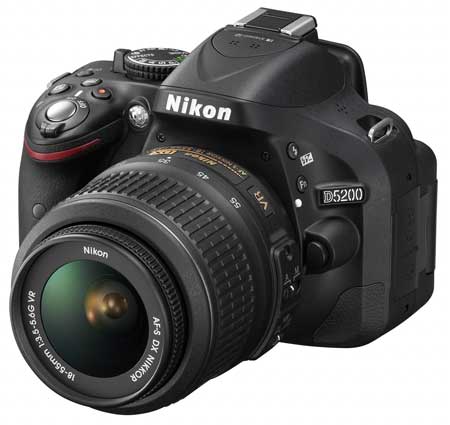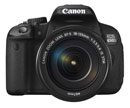Nikon D5200 review
-
-
Written by Ken McMahon
Verdict
The Nikon D5200 is the successor to the upper entry level D5100. It’s an advanced DSLR aimed at beginners and those looking for something a little more sophisticated than an entry level model. It sits between the D3200 and the D7100 in the Nikon DX line up, sharing the same 24 Megapixel resolution as the former, but with a newly designed sensor offering better noise performance and higher dynamic range.
On the surface the D5200 looks almost identical to its predecessor, but there are other internal changes as well as the new sensor. The AF system has been updated and now boasts 39 AF points 9 of which are cross-type sensors. The sensitivity range is expanded to 25,600 ISO and there’s a new 2-shot HDR composite mode. Continuous shooting performance is boosted to 5fps for a long burst of 100 shots and you can begin a new burst almost immediately.
The D5200’s movie shooting capabilities are also improved. Though the addition of a 1080i mode won’t excite too many people, the ability to manually set shutter speed and ISO settings is welcome, though it doesn’t go as far as the full PASM mode control of the EOS T4i / 650D. Built-in stereo mics with audio level control are also a step up from the mono mic of the D5100 and, as before, you can plug an external mic into the 3.5mm jack. You can take a full resolution video feed from the HDMI port either to drive an external monitor or to capture and process externally.
The D5200’s info displays have been redesigned and with the addition of a dedicated drive mode button make for an improved handling experience, though on occassions there’s still too much button pressing required to get to frequently used settings. The D5200 can also be operated remotely via an iOS or Android smartphone using the WU-1A wireless mobile adapter. This is a really neat idea and Nikon have made it straighforward and easy to use, but it feels very much like a first effort. The app design has plenty of room for improvement both in terms of the features it offers as well as the design.
Finally there’s the quality. The D5200’s new 24 Megapixel sensor has the potential, with the right lens, to produce a high level of detail with unprecedentedly low levels of noise for a sensor of this size and resolution. Unfortunately the 18-55mm kit lens doesn’t do either the sensor, or the focussing system justice and you might want to consider a different lens, possibly the Nikkor 18-135mm or 16-85mm.
 |
Compared to Canon EOS T4i / 650D
The Canon EOS Rebel 4Ti / 650D is Canon’s upper entry level DSLR and a direct competitor for the similarly priced D5200. It’s a little larger and a little heavier than the D5200 especially when fitted with the 18-135mm kit lens, which has a better build quality than the Nikkor 18-55mm, and feels like a more robust model.
The most obvious difference internally is the sensor resolution. Both models have APS-C sized sensors but the Canon has 18 Megapixels against 24 Megapixels on the Nikon D5200. Ordinarily you’d expect the higher pixel density on the D5200 to produce bigger images with worse noise, but my test showed that the opposite was in fact the case and the D5200 beats the EOS T4i / 650D on noise performance across the sensitivity range.
Another difference between these models is in their respective AF systems – a conventional 39-point phase detect AF system on the D5200 vs a hybrid system on the Canon with both a 9-point phase-detect system with the mirror down and a hybrid system in Live view which uses both contrast-detect and phase-detect points on the sensor. Though the D5200 has a far greater number of PDAF points, all of the EOS T4i’s are cross type sensors and in practice there’s little difference in performance. In my tests the D5200 was a little slower, but mostly because of the slow performance of the 18-55mm kit lens. In Live view mode and for movies though, the EOS T4i / 650D’s continuous focussing is a lot quicker and surer and doesn’t hunt around incessantly the way the D5200 does.
The other factior that makes a difference to the focussing performance, especially during movie recording is the Canon’s touch-screen which you can just tap to set the AF point. But the influence of the EOS T4i / 640D’s touch-screen extends beyond focussing, making the Canon a much easier camera to get along with from a handling perspective. The touch screen makes getting to any of the settings a much more direct prospect than on the D5200 where you have to navigate menus using the control pad. Even without the touch-screen, the secondary controls on the EOS T4i / 650D’s four-way controller mean you can quickly get to white balance, AF mode and Picture style settings without sacrificing the ISO button or having to first navigate a menu as on the D5200.
Aside from the EOS T4i / 650D’s touch-sensitivity, in other respects the screens are very similar, with roughly equivalent resolutions and the same side-hinged articulation, the Canon’s is a little wider though and 3:2 images fill the display in live view and during playback.
In terms of continuous shooting, both cameras share the same 5fps speed. The EOS T4i / 650D will continue at that pace until the card is full, whereas the D5200 (like all Nikon cameras) stops after 100 shots, though you can continue with another 100-frame burst immediately. The metering system of the D5200 is certainly more sophisticated, with a 2016 pixel sensor compared to the 63-zone system of the Canon. But again when comparing Canon and Nikon DSLRs with the same metering systems, I wouldn’t say one has a noticeable advantage over the other.
Both companies have resisted fitting GPS or Wifi as standard on their upper entry-level DSLRs, but the D5200 does at least officially support GPS and Wifi accessories, the latter allowing you to not only wirelessly transfer images from the camera, but also remote control it with a compatible Apple or Android smartphone, albeit with a rudimentary level of control. This is a really nice benefit the latest Nikon models have over the older Canon ones until Canon either starts integrating wireless (as it has with the higher-end EOS 6D) or develops the EOS Utility to play nicely with Eye-Fi cards and run on mobile operating systems.
For video, again it’s quite closely matched with both models offering Full HD modes at 24 and 25 or 30fps. Both now have built-in stereo mics with contol over audio levels as well as a socket for an external mic. The T4i / 650D also has the video snapshot feature which captures a series of short clips at predefined lengths of 2, 4 or 8 seconds and adds them all to an album. Added to that, the touch-screen focussing is something that can’t be underestimated. Countering that, and probably of more interest to serious videographers is the D5200’s ability to ouput a ‘clean’ signal free of graphics overlays via the HDMI port at 1080p resolution.
So, it’s not as clear cut a choice as the specs might lead you to believe. The fact that the D5200 offers higher resolution coupled with superior noise performance is a win-win that will be enough to convince anyone already leaning in that direction. Despite that, I found myself liking the EOS T4i / 650D’s touch-screen and overall handling better. Ultimately you’ll need to carefully compare the pros and cons and choose the one which best suits your requirements.
See my Canon EOS T4i / 650D review for more details.
Nikon D5200 final verdict
The D5200 is a solid upgrade to Nikon’s upper entry level model and a real advance in a number of key areas. Its AF and metering systems were previously only available on the next model up the range – the D7000 and it has a brand new 24 Megapixel sensor that defies expectations where noise performance is concerned, delivering superior results to its main competitor, the Canon EOS Rebel T4i / 650D.
The handling is better than its predecessor and there are some nice touches, like the intelligent Auto ISO override in PASM modes, the viewfinder grid overlay and the redesigned info panel. But there’s still room for improvement and niggles to be ironed out. A viewfinder proximity sensor should be standard on this level of model and access to frequently used functions needs to be more direct. Also, as we’ve seen on other Nikon DSLR’s servo focussing for movies is too erratic to be of much practical use.
If you can live with those, to be fair, minor pitfalls, the D5200 offers a level of quality and performance that’s hard to beat at this price point. For that and for achieving the genuinely remarkable, not to say surprising feat of producing a mid-range SLR with a 24 Megapixel sensor that offers truly stunning low noise performance its a deserving recipient of the Cameralabs Highly Recommended Award.
Bad points | Scores (relative to 2013 budget DSLRs) |
 | ||
Build quality: Image quality: Handling: Specification: Value:
Overall: |
16 / 20 18 / 20 17 / 20 16 / 20 17 / 20
84% | |||





